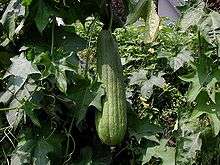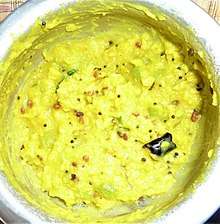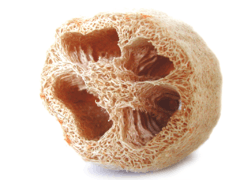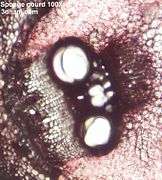Luffa
| Luffa | |
|---|---|
 | |
| Egyptian luffa with nearly mature fruit | |
| Scientific classification | |
| Kingdom: | Plantae |
| Clade: | Angiosperms |
| Clade: | Eudicots |
| Clade: | Rosids |
| Order: | Cucurbitales |
| Family: | Cucurbitaceae |
| Subfamily: | Cucurbitoideae |
| Tribe: | Sicyoeae |
| Genus: | Luffa Mill.[1] |
| Species | |
| |
| Synonyms | |
Luffa is a genus of tropical and subtropical vines in the cucumber family (Cucurbitaceae).
In everyday non-technical usage, the luffa, also spelled loofah (referred to as gilka torai or ram torai in 1 of the languages in India; 丝瓜 in Simplified Chinese, 絲瓜 in Traditional Chinese (Pinyin: sī guā), usually means the fruit of the two species L. aegyptiaca and L. acutangula. The fruit of these species is cultivated and eaten as a vegetable. The fruit must be harvested at a young stage of development to be edible. The vegetable is popular in India, China and Vietnam.[2] When the fruit is fully ripened, it is very fibrous. Various dishes of gilki are prepared in India and eaten. The fully developed fruit is the source of the loofah scrubbing sponge which is used in bathrooms and kitchens. Luffa are not frost-hardy, and require 150 to 200 warm days to mature.
The name luffa was taken by European botanists in the 17th century from the Egyptian Arabic name لوف lūf.[1]
Uses
Fibers
The fruit section of L. aegyptiaca may be allowed to mature and used as a bath or kitchen sponge after being processed to remove everything but the network of xylem fibers. If the loofah is allowed to fully ripen and then dried on the vine, the flesh disappears leaving only the fibrous skeleton and seeds, which can be easily shaken out. Marketed as luffa or loofah, the sponge is used as a body scrub.
In Paraguay, panels are made out of luffa combined with other vegetable matter and recycled plastic. These can be used to create furniture and construct houses.[3]
Food

.jpg)
Luffa are best eaten when small (less than 12 cm or 4.5 inches in length) and still green.
In Vietnamese cuisine, the gourd is called "mướp hương" and is a common ingredient in soups and stir-fried dishes.
In Myanmar, it is known as that pwet thee (သဗွတ်သီး).
In Hindi-speaking North Indian states, it is called torai (तोरई), and cooked as vegetable. But in central/Western India specially in MP, it is called gilki (गिल्की). Torai is reserved for ridge gourd and is less popular than gilki in central western India.
In Gujarat it is known as turia or turya as well as ghissori or ghissora in the Kutchi language. It is a simple but very popular vegetable usually made with a plentiful tomato gravy and garnished with green chillies and fresh coriander. Even the most fussy children find this vegetable appetizing and tasty to eat as cooked roti is popularly shredded by hand and mixed into it, which is colloquially known as "rotli shaak ma bhuseli". Alternatively this dish is also eaten mixed with plain cooked rice.
In Bengali-speaking Bangladesh and the Indian state of West Bengal, it is known as jhinge (ঝিঙে) and a popular vegetable. It is eaten fried or cooked with shrimp, fish, or meat.
In Assam, it is called bhul (ভুল) and is cooked with sour fish curry along with taro.
In Tamil Nadu, the gourd is called peerkangai and used as a vegetable to make peerkangai kootu, poriyal, and thogayal. Even the skin is used to make chutney.
In Karnataka's Malenadu (Western Ghats) it is known as tuppadahirekayi, which literally translates as "buttersquash". It grows naturally in this region and is consumed when it is still tender and green. It is used as a vegetable in curries, but also as a snack, bhajji, dipped in chickpea batter and deep fried.
In Andhra Pradesh, it is called nethi beerakaya or beerakaya. And in Assam it is called jika (জিকা, Luffa acutangula) and bhula (ভোল, Luffa aegyptiaca). It is used as a vegetable in a curry, chutney and stir fry.
In Kerala, it is called peechinga; in the Palakkad area it is particularly called poththanga and used in while bathing. It is also used as a vegetable, cooked with dal or stir fried. Fully matured fruit is used as a natural scrub in rural Kerala. In some places such as Wayanad, it grows as a creeper on fences.
In Maharashtra, India, dodka (ridge gourd luffa) and ghosavala (smooth luffa) are common vegetables prepared with either crushed dried peanuts or with beans.
In Manipur, India, Sebot is cooked with other ingredients like potato, dried fish, fermented fish and served. It is also steamed and consumed or crushed (Ironba) with other ingredients and served with steamed rice (Chaak). Fried ones (Kaanghou) are also favorites for many.
In Japan, it is called hechima (へちま) and is cultivated all over the country during summer. It is commonly used as a green vegetable in traditional dishes of the Nansei Islands and Kyushu while other regions of Japan grow it predominantly for use as a sponge or for applying soap, shampoo, and lotion. As with bitter melon, many people grow it outside building windows as a natural sunscreen in summer.
In China, Taiwan, and Indonesia (where it is called Sigua or oyong), the Philippines (where it is called patola) and Manipur, India, (where it is called sebot) the luffa is eaten as a green vegetable in various dishes. It is also known as "Chinese okra" in Canada and the U.S. In Spanish, it is called an estropajo.
Luffa species are used as food plants by the larvae of some Lepidoptera species, including Hypercompe albicornis. In Myanmar, (where it is called tha-boot-thee သပြတ္သီး) probably derived from the word sebot in Manipur. When it is young it is used as food.
Gallery
 A bag of dried mature luffa fruits.
A bag of dried mature luffa fruits. Luffa acutangula seeds. Each division of the ruler is 1 mm. Seeds of Luffa aegyptica look very similar.
Luffa acutangula seeds. Each division of the ruler is 1 mm. Seeds of Luffa aegyptica look very similar. A luffa sponge whose coarse texture helps with skin polishing.
A luffa sponge whose coarse texture helps with skin polishing. Luffa aegyptiaca sponge section magnified 100 times
Luffa aegyptiaca sponge section magnified 100 times Habitus of the vine
Habitus of the vine Luffa aegyptiaca - MHNT
Luffa aegyptiaca - MHNT Luffa operculata - MHNT
Luffa operculata - MHNT Luffa in a coconut tree
Luffa in a coconut tree
See also
References
- 1 2 The plant name "luffa" was introduced to Western botany nomenclature by the botanist Johann Vesling (died 1649), who visited Egypt in the late–1620s and described the plant under cultivation with artificial irrigation in Egypt. In 1706 the botanist Joseph Pitton de Tournefort introduced the formal botany genus name "Luffa". Tournefort referred to Veslingius's earlier description and reiterated that "Luffa Arabum" is a plant from Egypt in the cucumber family. In establishing the genus Luffa, Tournefort identified just one member species and called it "Luffa Arabum". His 1706 article includes detailed drawings of this species (which is now called Luffa aegyptiaca). The species is native to tropical Asia but has been under cultivation in Egypt since late medieval times. The botanist Peter Forsskål visited Egypt in the early–1760s and noted that it was called ليف lūf in Arabic. In the 18th century the botanist Linnaeus adopted the name luffa for this species but assigned it to the genus Momordica, and did not use a separate genus Luffa. More refs on Luffa in 18th century botanical nomenclature: "A commentary on Loureiro's "Flora Cochinchinensis" ", by E.D. Merrill, year 1935, in Transactions of American Philosophical Society volume 24 part 2, pp 377-378. Luffa @ ATILF and "Suite de l'Etablissement de Quelques Nouveaux Genres de Plantes", by J.P. de Tournefort (1706) in Mémoires de l'Academe Royale des Sciences année 1706.
- ↑ "Luffa aegyptiaca". Floridata.com. Retrieved September 15, 2013.
- ↑ rolexawards.com; Recyclable homes, Rolex Awards 2008
External links
| Wikimedia Commons has media related to Luffa. |